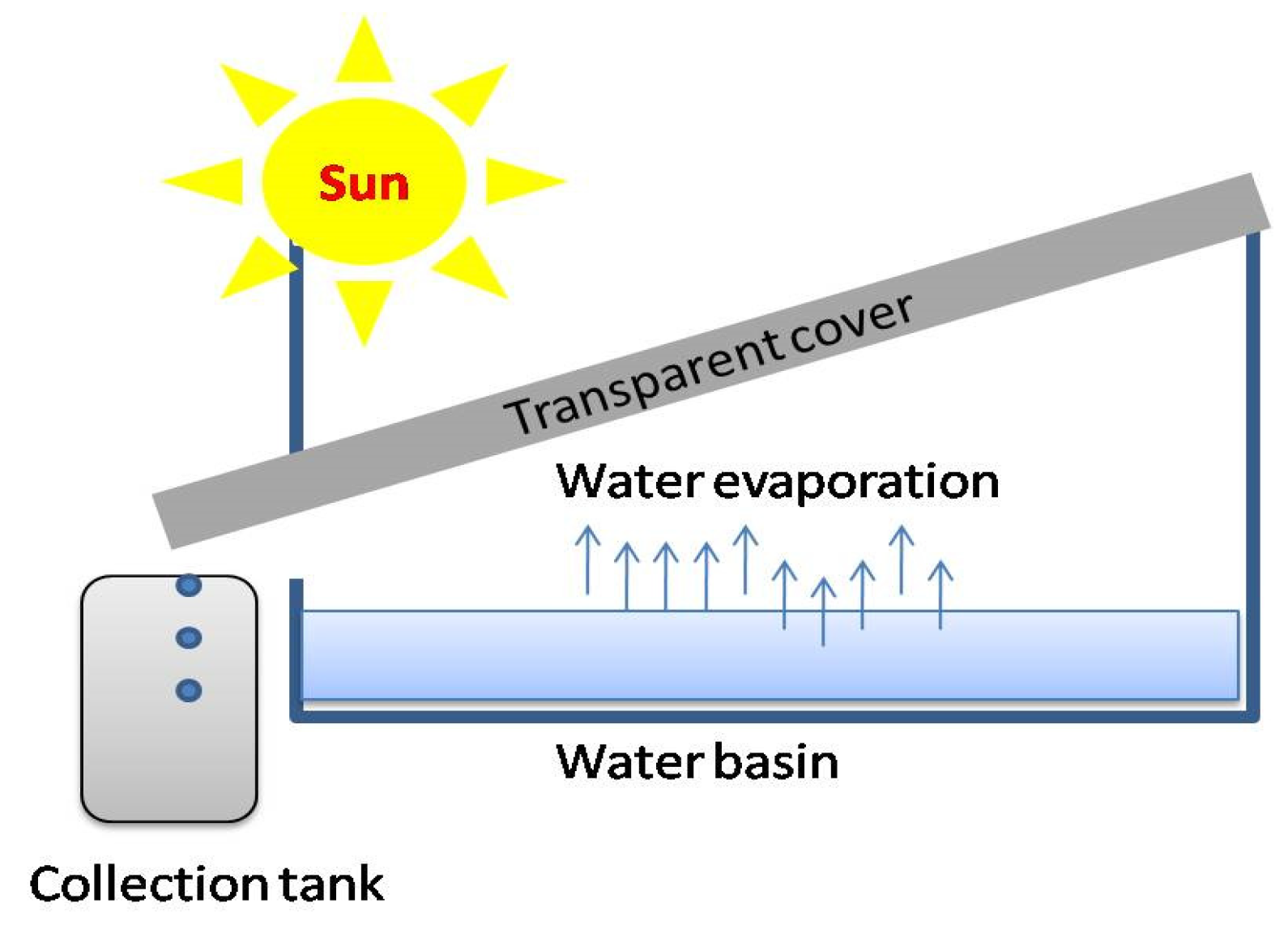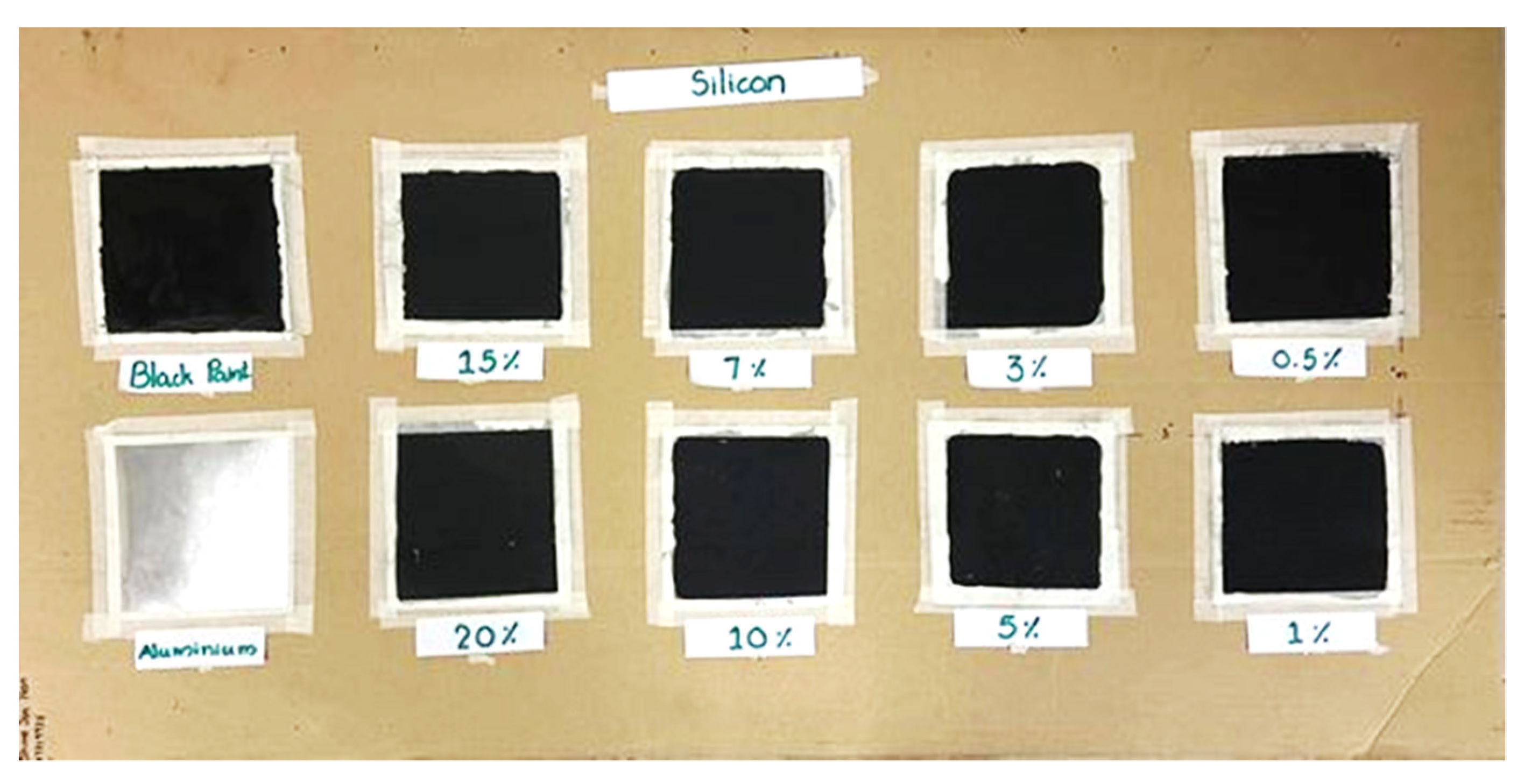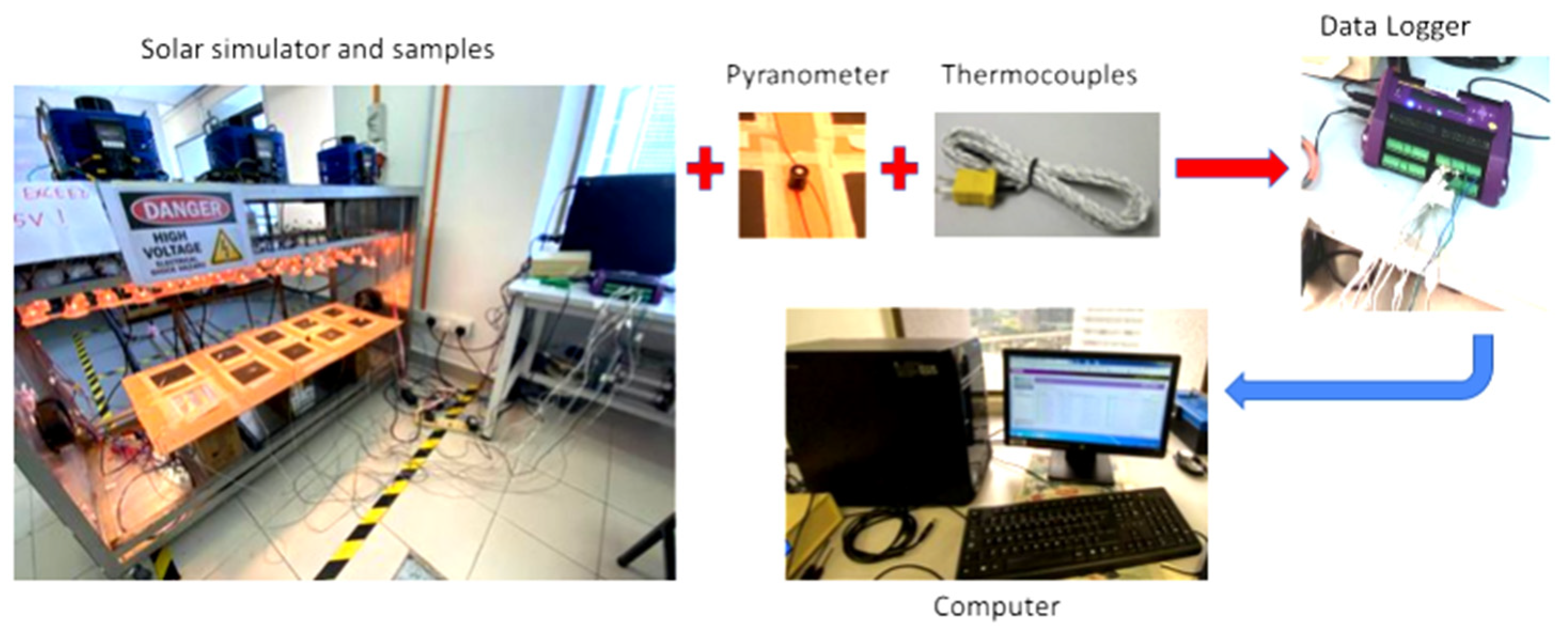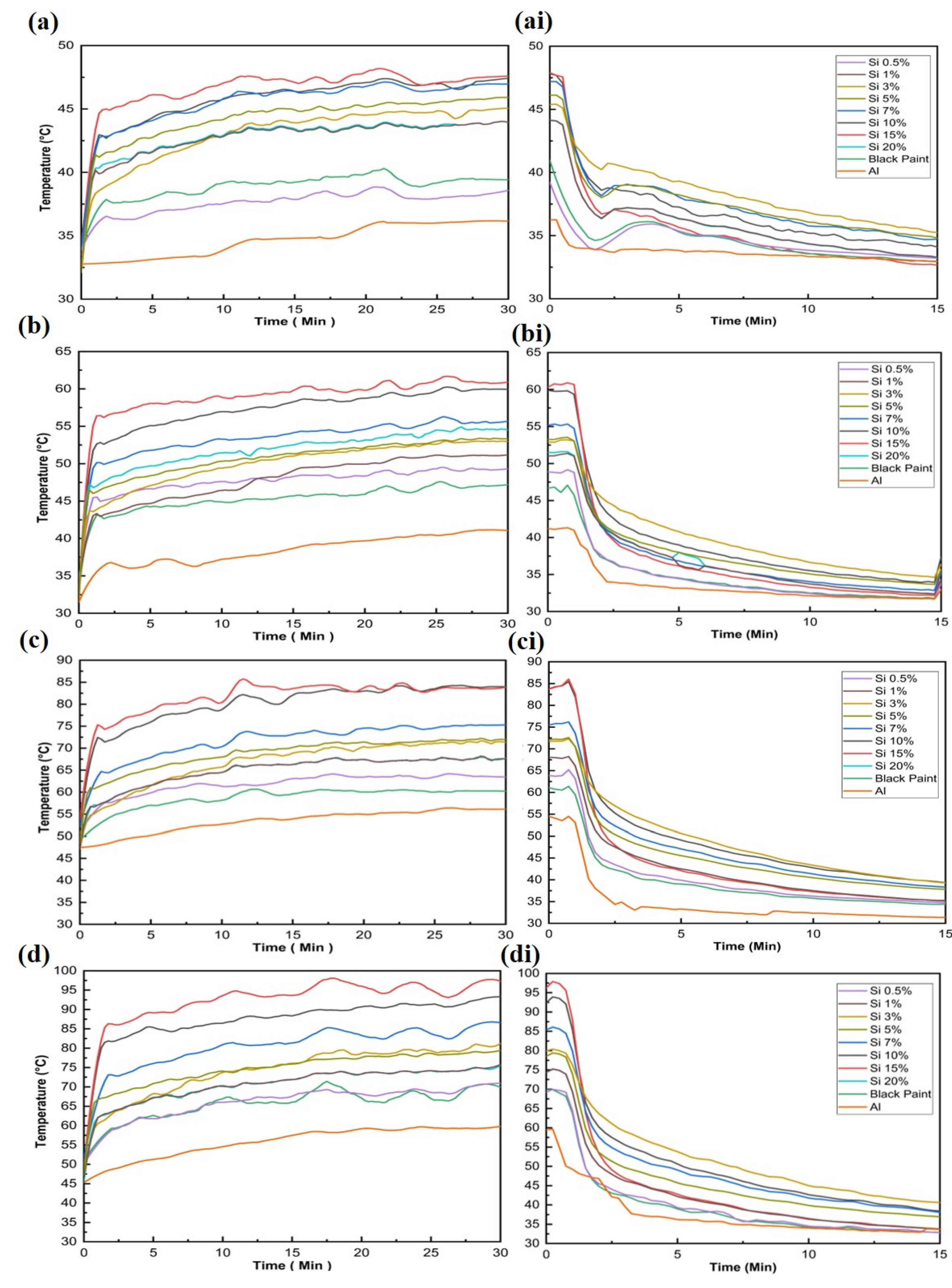Silicon Particles/Black Paint Coating for Performance Enhancement of Solar Absorbers
Abstract
:1. Introduction
2. Experimental Investigation
2.1. Samples Preparation
2.2. Indoor Setup and Experimental Procedure
2.3. Outdoor Setup and Experimental Procedure
3. Results and Discussion
3.1. Indoor Analysis
3.2. Outdoor Analysis
4. Conclusions
Author Contributions
Funding
Informed Consent Statement
Data Availability Statement
Acknowledgments
Conflicts of Interest
References
- Biswas, A.K.; Tortajada, C. Water Crisis and Water Wars: Myths and Realities; Taylor & Francis: Abingdon, UK, 2019. [Google Scholar]
- Llácer-Iglesias, R.M.; López-Jiménez, P.; Pérez-Sánchez, M. Energy Self-Sufficiency Aiming for Sustainable Wastewater Systems: Are All Options Being Explored? Sustainability 2021, 13, 5537. [Google Scholar] [CrossRef]
- Fayaz, H.; Ahmad, M.S.; Pandey, A.K.; Abd Rahim, N.; Tyagi, V.V. A Novel Nanodiamond/Zinc Nanocomposite as Potential Counter Electrode for Flexible Dye Sensitized Solar Cell. Solar Energy 2020, 197, 1–5. [Google Scholar] [CrossRef]
- Pandey, A.; Ahmad, M.S.; Alizadeh, M.; Rahim, N.A. Improved electron density through hetero-junction binary sensitized TiO2/CdTe/D719 system as photoanode for dye sensitized solar cell. Phys. E Low-Dimens. Syst. Nanostruct. 2018, 101, 139–143. [Google Scholar] [CrossRef]
- Liu, S.; Wang, Z.; Han, M.; Wang, G.; Hayat, T.; Chen, G. Energy-water nexus in seawater desalination project: A typical water production system in China. J. Clean. Prod. 2020, 279, 123412. [Google Scholar] [CrossRef]
- Besha, A.T.; Tsehaye, M.T.; Tiruye, G.A.; Gebreyohannes, A.Y.; Awoke, A.; Tufa, R.A. Deployable Membrane-Based Energy Technologies: The Ethiopian Prospect. Sustainability 2020, 12, 8792. [Google Scholar] [CrossRef]
- Liu, F.; Wang, L.; Bradley, R.; Zhao, B.; Wu, W. Highly efficient solar seawater desalination with environmentally friendly hierarchical porous carbons derived from halogen-containing polymers. RSC Adv. 2019, 9, 29414–29423. [Google Scholar] [CrossRef] [Green Version]
- Alawi, O.; Kamar, H.; Mallah, A.; Mohammed, H.; Sabrudin, M.; Newaz, K.; Najafi, G.; Yaseen, Z. Experimental and Theoretical Analysis of Energy Efficiency in a Flat Plate Solar Collector Using Monolayer Graphene Nanofluids. Sustainability 2021, 13, 5416. [Google Scholar] [CrossRef]
- Abujazar, M.S.S.; Fatihah, S.; Kabeel, A. Seawater desalination using inclined stepped solar still with copper trays in a wet tropical climate. Desalination 2017, 423, 141–148. [Google Scholar] [CrossRef]
- Ahmad, M.; Han, S.; Zafar, A.; Ghafoor, U.; Rahim, N.; Ali, M.; Rim, Y. Indoor and Outdoor Performance Study of Metallic Zinc Particles in Black Paint to Improve Solar Absorption for Solar Still Application. Coatings 2021, 11, 536. [Google Scholar] [CrossRef]
- Srithar, K.; Rajaseenivasan, T. Recent fresh water augmentation techniques in solar still and HDH desalination—A review. Renew. Sustain. Energy Rev. 2018, 82, 629–644. [Google Scholar] [CrossRef]
- Kabeel, A.; Sathyamurthy, R.; Sharshir, S.; Manokar, M.; Panchal, H.; Prakash, N.; Prasad, C.; Nandakumar, S.; El Kady, M. Effect of water depth on a novel absorber plate of pyramid solar still coated with TiO2 nano black paint. J. Clean. Prod. 2019, 213, 185–191. [Google Scholar] [CrossRef]
- Saleh, S.M.; Soliman, A.M.; Sharaf, M.A.; Kale, V.; Gadgil, B. Influence of solvent in the synthesis of nano-structured ZnO by hydrothermal method and their application in solar-still. J. Environ. Chem. Eng. 2017, 5, 1219–1226. [Google Scholar] [CrossRef]
- Abdelal, N.; Taamneh, Y. Enhancement of pyramid solar still productivity using absorber plates made of carbon fiber/CNT-modified epoxy composites. Desalination 2017, 419, 117–124. [Google Scholar] [CrossRef]
- Baticados, E.J.N.; Capareda, S.C.; Liu, S.; Akbulut, M. Advanced Solar Still Development: Improving Distilled Water Recovery and Purity via Graphene-Enhanced Surface Modifiers. Front. Environ. Sci. 2020, 8, 531049. [Google Scholar] [CrossRef]
- Kabeel, A.; Omara, Z.; Essa, F.; Abdullah, A.; Arunkumar, T.; Sathyamurthy, R. Augmentation of a solar still distillate yield via absorber plate coated with black nanoparticles. Alex. Eng. J. 2017, 56, 433–438. [Google Scholar] [CrossRef]
- Sathyamurthy, R.; Kabeel, A.E.; Balasubramanian, M.; Devarajan, M.; Sharshir, S.W.; Manokar, M. Experimental study on enhancing the yield from stepped solar still coated using fumed silica nanoparticle in black paint. Mater. Lett. 2020, 272, 127873. [Google Scholar] [CrossRef]
- Tenthani, C.; Madhlopa, A.; Kimambo, C.Z.M. Improved Solar Still for Water Purification. J. Sustain. Energy Environ. 2012, 3, 111–113. [Google Scholar]
- Modi, K.V.; Jani, H.K.; Gamit, I.D. Impact of orientation and water depth on productivity of single-basin dual-slope solar still with Al2O3 and CuO nanoparticles. J. Therm. Anal. Calorim. 2021, 143, 899–913. [Google Scholar] [CrossRef]
- Arunkumar, T.; Murugesan, D.; Raj, K.; Denkenberger, D.; Viswanathan, C.; Rufuss, D.D.W.; Velraj, R. Effect of nano-coated CuO absorbers with PVA sponges in solar water desalting system. Appl. Therm. Eng. 2019, 148, 1416–1424. [Google Scholar] [CrossRef]
- Kabeel, A.; Omara, Z.; Essa, F. Improving the performance of solar still by using nanofluids and providing vacuum. Energy Convers. Manag. 2014, 86, 268–274. [Google Scholar] [CrossRef]
- Yadav, A.K.; Chandel, S. Tilt angle optimization to maximize incident solar radiation: A review. Renew. Sustain. Energy Rev. 2013, 23, 503–513. [Google Scholar] [CrossRef]
- Wang, M.-S.; Fan, L.-Z. Silicon/carbon nanocomposite pyrolyzed from phenolic resin as anode materials for lithium-ion batteries. J. Power Sources 2013, 244, 570–574. [Google Scholar] [CrossRef]
- Meteoblue. Available online: https://www.meteoblue.com/en/weather/historyclimate/weatherarchive/kuala-lumpur_malaysia_1735161?fcstlength=1y&year=2020&month=12 (accessed on 22 December 2020).
- Tang, K.H.D. Climate change in Malaysia: Trends, contributors, impacts, mitigation and adaptations. Sci. Total Environ. 2019, 650, 1858–1871. [Google Scholar] [CrossRef]







| Instrument | Measuring Range | Accuracy |
|---|---|---|
| Pyranometer (Model: LI-COR, LI200R) | 0–2000 W/m2 | ±5% |
| Data Logger (Model: Data Taker DT80) | ±2% | |
| Thermocouple (K-Type) | −200–1000 °C | ±1.50 °C |
| Sr. No. | Matrix (Coated on Aluminum Sheet) | Silicon Concentration (wt %) | Maximum Temperature at 1000 W/m2 |
|---|---|---|---|
| 1 | Black paint | 0.5% | 72.8 ± 2% |
| 2 | Black paint | 1% | 75.7 ± 2% |
| 3 | Black paint | 3% | 79.4 ± 2% |
| 4 | Black paint | 5% | 81.8 ± 3% |
| 5 | Black paint | 7% | 87.8 ± 2% |
| 6 | Black paint | 10% | 93.4 ± 3% |
| 7 | Black paint | 15% | 98.5 ± 2% |
| 8 | Black paint | 20% | 79.3 ± 2% |
| 9 | Black paint | 0% | 71.9 ± 2% |
| 10 | Aluminum reference | 59.4 ± 2% |
| Sr. No. | Matrix (Coated on Aluminum Sheet) | Silicon Concentration (wt %) | Maximum Temperature (°C) | Average Temperature (°C) | Measuring Accuracy (°C) |
|---|---|---|---|---|---|
| 1 | Black paint | 0.5% | 68.9 | 44.0 | ±1.5 |
| 2 | Black paint | 1% | 69.4 | 44.0 | ±1.5 |
| 3 | Black paint | 3% | 70.5 | 44.5 | ±1.5 |
| 4 | Black paint | 5% | 70.9 | 44.8 | ±1.5 |
| 5 | Black paint | 7% | 71.3 | 45.6 | ±1.5 |
| 6 | Black paint | 10% | 73.2 | 45.6 | ±1.5 |
| 7 | Black paint | 15% | 72.7 | 45.6 | ±1.5 |
| 8 | Black paint | 20% | 70.3 | 44.3 | ±1.5 |
| 9 | Black paint | 0% | 68.8 | 43.4 | ±1.5 |
| 10 | Aluminum reference | 50.8 | 36.9 | ±1.5 |
Publisher’s Note: MDPI stays neutral with regard to jurisdictional claims in published maps and institutional affiliations. |
© 2021 by the authors. Licensee MDPI, Basel, Switzerland. This article is an open access article distributed under the terms and conditions of the Creative Commons Attribution (CC BY) license (https://creativecommons.org/licenses/by/4.0/).
Share and Cite
Han, S.S.; Ghafoor, U.; Saeed, T.; Elahi, H.; Masud, U.; Kumar, L.; Selvaraj, J.; Ahmad, M.S. Silicon Particles/Black Paint Coating for Performance Enhancement of Solar Absorbers. Energies 2021, 14, 7140. https://doi.org/10.3390/en14217140
Han SS, Ghafoor U, Saeed T, Elahi H, Masud U, Kumar L, Selvaraj J, Ahmad MS. Silicon Particles/Black Paint Coating for Performance Enhancement of Solar Absorbers. Energies. 2021; 14(21):7140. https://doi.org/10.3390/en14217140
Chicago/Turabian StyleHan, Shwe Sin, Usman Ghafoor, Tareq Saeed, Hassan Elahi, Usman Masud, Laveet Kumar, Jeyraj Selvaraj, and Muhammad Shakeel Ahmad. 2021. "Silicon Particles/Black Paint Coating for Performance Enhancement of Solar Absorbers" Energies 14, no. 21: 7140. https://doi.org/10.3390/en14217140
APA StyleHan, S. S., Ghafoor, U., Saeed, T., Elahi, H., Masud, U., Kumar, L., Selvaraj, J., & Ahmad, M. S. (2021). Silicon Particles/Black Paint Coating for Performance Enhancement of Solar Absorbers. Energies, 14(21), 7140. https://doi.org/10.3390/en14217140









